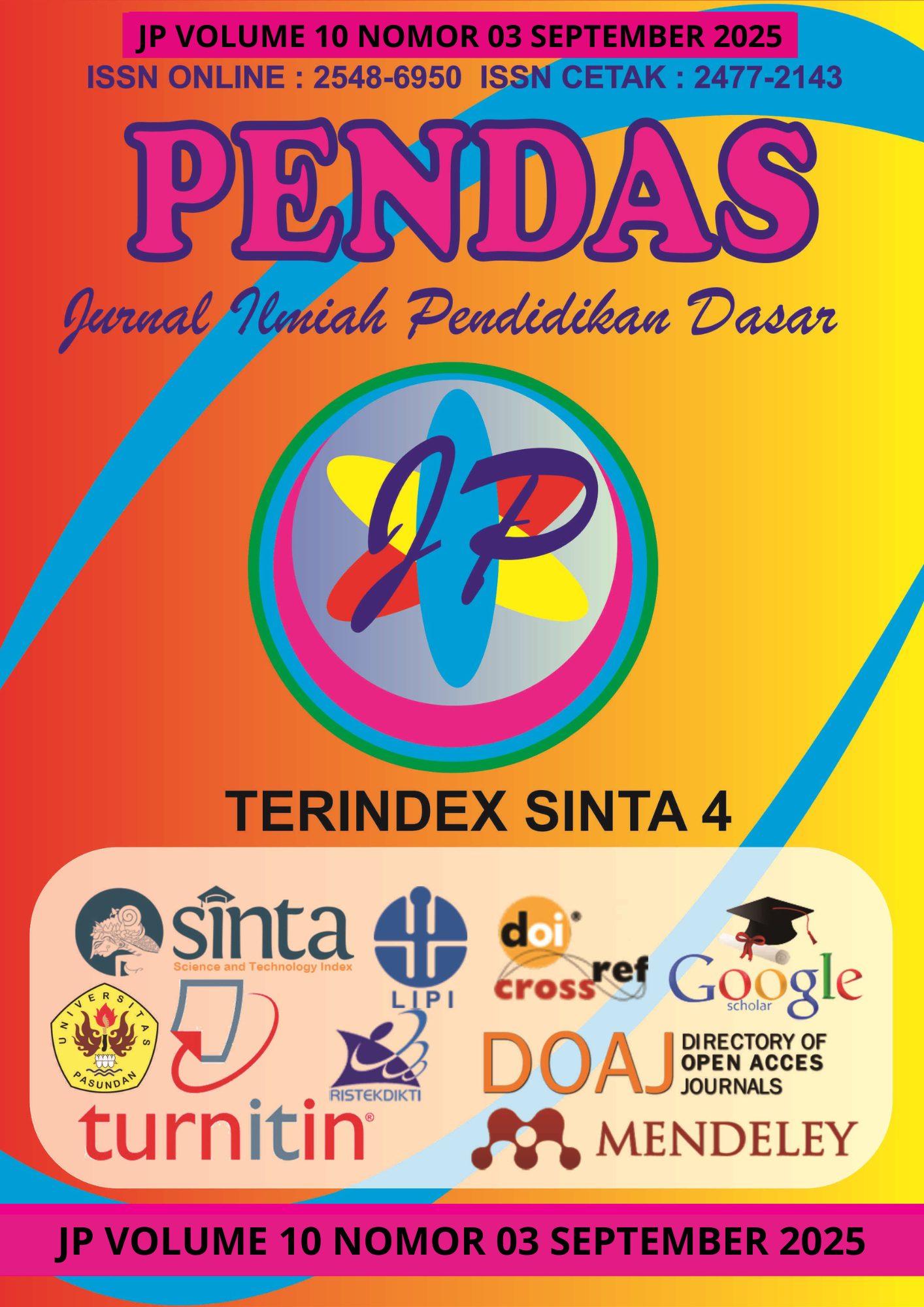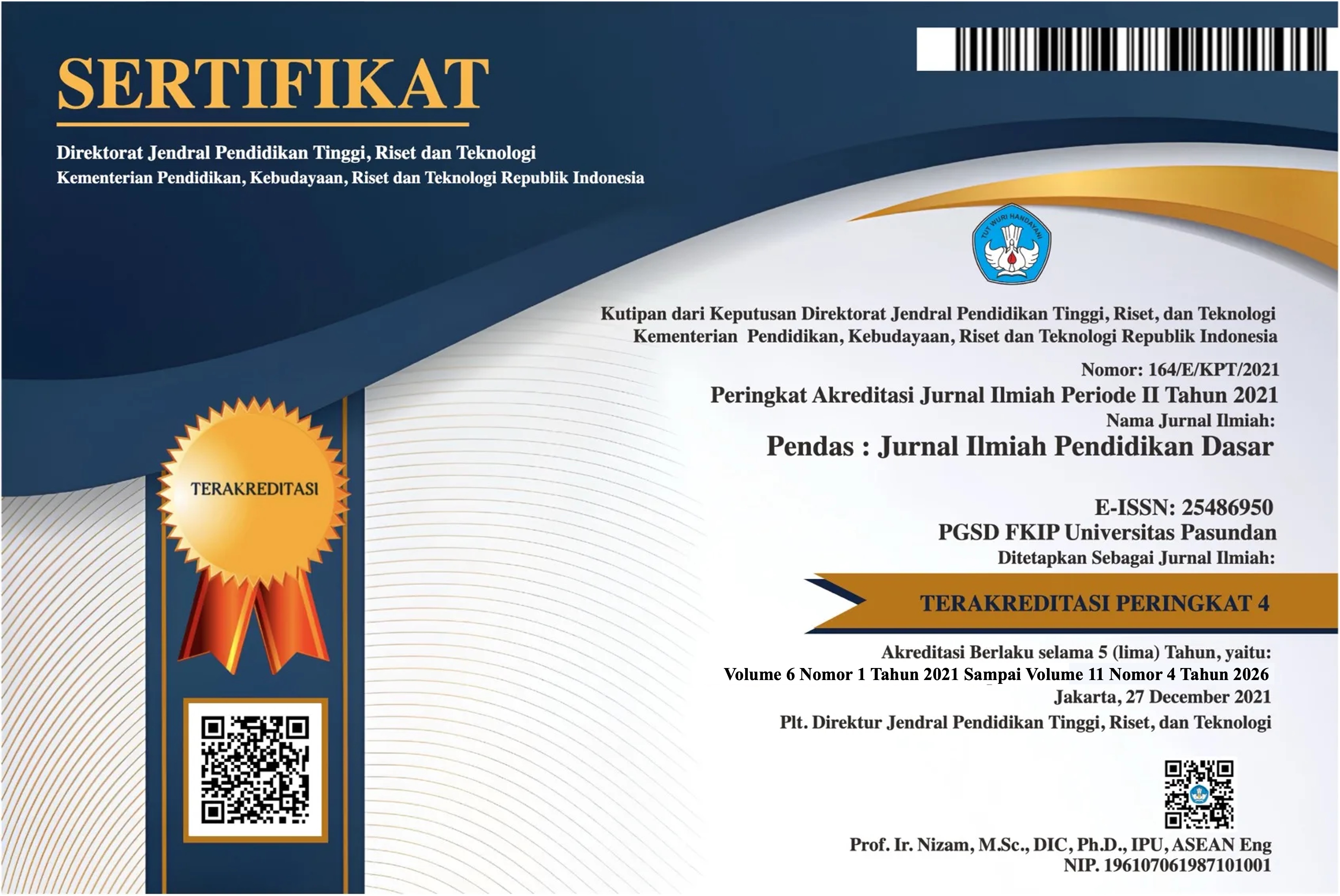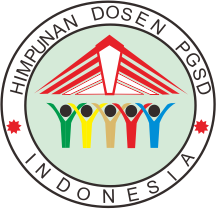PENGARUH PENDEKATAN STEAM (SCIENCCE, TECHNOLOGY, ENGINEERING, ARTS AND MATHEMATICS) TERHADAP KEMAMPUAN BERPIKIR KREATIF PESERTA DIDIK SD/MI
DOI:
https://doi.org/10.23969/jp.v10i3.30587Keywords:
creative thinking, learning approaches, STEAMAbstract
Students' creative thinking skills are currently generally inadequate because the teaching methodology in many elementary schools does not support the development of these abilities. This study aims to examine how the STEAM (Science, Technology, Engineering, Arts, and Mathematics) approach affects the creative thinking skills of students at Mergosono 2 Elementary School. This study used a quantitative approach with a quasi-experimental design with a non-equivalent control group design. The sample consisted of 20 students from the experimental class with the STEAM approach and 22 students from the control class with the expository approach. Pretest-posttest essay questions were used to collect data, and an independent t-test was used for data analysis. The results showed a value (sig. 2-tailed) with a total of (0.000) < 0.05, which means that the STEAM approach has an impact on students' creative thinking skills. The average score for the posttest of the experimental class, which used the STEAM approach, was 51.95, while the average score for the posttest of the control class, which used the expository approach, was 35.59.
Downloads
References
Arifin, Z. (2017). Mengembangkan Instrumen Pengukur Critical Thinking Skills Siswa pada Pembelajaran Matematika Abad 21. Jurnal THEOREMS (The Original Research of Mathematics), 1(2), 92–100. https://www.jurnal.unma.ac.id/index.php/th/article/view/383
Ariyana, Y., Pudjiastuti, A., Bestary, R., & Zamroni. (2018). Buku Pegangan Pembelajaran Keterampilan Berpikir Tingkat Tinggi Berbasis Zonasi. Buku Pegangan Pembelajaran Berorientasi Pada Keterampilan Berfikir Tingkat Tinggi, 1–87. https://repositori.kemdikbud.go.id/11316/1/01._Buku_Pegangan_Pembelajaran_HOTS_2018-2.pdf
Arsy, I., & Syamsulrizal, S. (2021). Pengaruh Pembelajaran STEAM (Science, Technology, Engineering, Arts, and Mathematics) terhadap Kreativitas Peserta Didik. Biolearning Journal, 8(1), 24–26. https://doi.org/10.36232/jurnalbiolearning.v8i1.1019
Deák, C., Kumar, B., Szabó, I., Nagy, G., & Szabolcs, S. (2021). education sciences Evolution of New Approaches in Pedagogy and STEM with. Educ. Sci, 19, 1–16.
Ghufron, M. N., & Risnawita, R. S. (2015). Teori-teori Psikologis (p. 202).
Hendriana, H., & Fadhilah, F. M. (2019). the Students’ Mathematical Creative Thinking Ability of Junior High School Through Problem-Solving Approach. Infinity Journal, 8(1), 11–20. https://doi.org/10.22460/infinity.v8i1.p11-20
Hidayat, W., Wahyudin, & Prabawanto, S. (2018). Improving students’ creative mathematical reasoning ability students through adversity quotient and argument driven inquiry learning. Journal of Physics: Conference Series, 948(1). https://doi.org/10.1088/1742-6596/948/1/012005
Khoiriyah, A. J., & Husamah, H. (2018). Problem-based learning: Creative thinking skills, problem-solving skills, and learning outcome of seventh grade students. JPBI (Jurnal Pendidikan Biologi Indonesia), 4(2), 151–160. https://doi.org/10.22219/jpbi.v4i2.5804
Manobe, S. M., & Wardani, K. W. (2018). Peningkatan Kreativitas Belajar IPA Menggunakan Model Problem Based Learning Pada Siswa Kelas 3 SD. Didaktika Dwija Indria, 6(9), 159–171. https://jurnal.fkip.uns.ac.id/index.php/pgsdsolo/article/view/12003
Maulana, I. (2022). Pendekatan Science, Technology, Engineering, Art and Mathematics (Steam) Terhadap Kemampuan Berpikir Kreatif Siswa : Studi Meta- Analisis. 1–125.
Nasrah, Amir, H. R., & Purwanti, R. Y. (2021). Efektivitas Model Pembelajaran Steam (Science, Technology, Engineering, Art, And Mathematics) Pada Siswa Kelas IV SD. JKPD) Jurnal Kajian Pendidikan Dasar, 6 Nomor 1, 1–13. https://journal.unismuh.ac.id/index.php/jkpd/article/view/4166
Nisyak, I. K. (2022). Duplikasi Alat Musik Tradisional Jawa Tengah Dalam Pembelajaran STEAM Topik Getaran, Gelombang, Dan Bunyi Untuk Melatih Keterampilan Berpikirkreatif Siswa Kelas VIII Mts Darul Ulum Tahun 2021/2022. Galang Tanjung, X(2504), 1–9.
Nurfadilah, S., & Siswanto, J. (2020). Analisis Kemampuan Berpikir Kreatif pada Konsep Polimer dengan Pendekatan STEAM Bermuatan ESD Siswa SMA Negeri 1 Bantarbolang. Media Penelitian Pendidikan : Jurnal Penelitian Dalam Bidang Pendidikan Dan Pengajaran, 14(1), 45–51. https://doi.org/10.26877/mpp.v14i1.5543
Nurohmah, A. N., Kartini, D., & Rustini, T. (2023). Relevansi Kebijakan Kurikulum Merdeka Dengan Pendidikan Abad 21 Pada Pembelajaran IPS di SD. Jurnal Ilmiah Wahana Pendidikan, Februari, 9(3), 25. https://doi.org/10.5281/zenodo.7594483
Quigley, C. F., Herro, D., & Jamil, F. M. (2017). Developing a Conceptual Model of STEAM Teaching Practices. School Science and Mathematics, 117(1–2), 1–12. https://doi.org/10.1111/ssm.12201
Rahmawati, N. (2020). Analisis Kebutuhan Media Dan Bahan Ajar Berbasis Augmented Reality Dalam Pembelajaran Ipa Pendekatan STEAM Keterampilan Abad 21 Guru Sekolah Dasar. Social, Humanities, and Education Studies (SHEs): Conference Series, 3(4), 1241–1248.
Rahmazatullaili, R., Zubainur, C. M., & Munzir, S. (2017). Kemampuan berpikir kreatif dan pemecahan masalah siswa melalui penerapan model project based learning. Beta: Jurnal Tadris Matematika, 10(2), 166–183. https://doi.org/10.20414/betajtm.v10i2.104
Rauf, I., Arifin, I. N., & Arif, R. M. (2022). Pengaruh Model Problem Based Learning Terhadap Kemampuan Berpikir Kritis Siswa. Pedagogika, 1, 163–183. https://doi.org/10.37411/pedagogika.v13i2.1354
Salsabila, Y., Fatah, A., & Jaenudin, J. (2023). Hubungan antara Literasi Numerasi terhadap Kemampuan Berpikir Kritis dan Kreatif Siswa SMP di Kecamatan Curug. EQUALS: Jurnal Ilmiah Pendidikan Matematika, 6(1), 42–54. https://doi.org/10.46918/equals.v6i1.1789
Sugiyono. (2023). Metode Penelitian Kuantitatif, Kualitatif dan R&D. In Sustainability (Switzerland) (Vol. 11, Issue 1). http://scioteca.caf.com/bitstream/handle/123456789/1091/RED2017-Eng-8ene.pdf?sequence=12&isAllowed=y%0Ahttp://dx.doi.org/10.1016/j.regsciurbeco.2008.06.005%0Ahttps://www.researchgate.net/publication/305320484_SISTEM_PEMBETUNGAN_TERPUSAT_STRATEGI_MELESTARI
Syafi’i, I., & Dianah, N. D. (2021). Pemanfaatan Loose Parts Dalam Pembelajaran Steam Pada Anak Usia Dini. Aulada : Jurnal Pendidikan Dan Perkembangan Anak, 3(1), 105–114. https://doi.org/10.31538/aulada.v3i1.1203
Syahrir. (2016). Pengembangan Perangkat Pembelajaran Matematika SMP untuk Meningkatkan Kemampuan Berpikir Kreatif. 4(June), 2016.
Taylor, P. C. (2016). Why is a STEAM curriculum perspective crucial to the 21st century ? Australian Curriculum : Science. Research Conference 2016, August, 89–93.
Wahyuningsih, S., Nurjanah, N. E., Rasmani, U. E. E., Hafidah, R., Pudyaningtyas, A. R., & Syamsuddin, M. M. (2020). STEAM Learning in Early Childhood Education: A Literature Review. International Journal of Pedagogy and Teacher Education, 4(1), 33. https://doi.org/10.20961/ijpte.v4i1.39855
Wijayanti, I. D., & Ekantini, A. (2023). Implementasi Kurikulum Merdeka Pada Pembelajaran IPAS MI/SD. Peran Kepuasan Nasabah Dalam Memediasi Pengaruh Customer Relationship Marketing Terhadap Loyalitas Nasabah, 2(3), 310–324. https://bnr.bg/post/101787017/bsp-za-balgaria-e-pod-nomer-1-v-buletinata-za-vota-gerb-s-nomer-2-pp-db-s-nomer-12
Wilson, B., & Hawkins, B. (2019). Circe Magazine : STEAM Edition. Circe Magazine, January, 27.
Zubaidah, S. (2019). STEAM (science, technology, engineering, arts, and mathematics): Pembelajaran untuk memberdayakan keterampilan abad ke-21 [STEAM (Science, Technology, Engineering, Arts, and Mathematics): Learning to Empower 21st Century Skills]. Seminar Nasional Matematika Dan Sains, September, 1–18.
Zulaikah, S., Hidayati, Y., Hadi, W. P., & Muharrami, L. K. (2023). Identifikasi Kemampuan Berpikir Kreatif Siswa: Penerapan Model Pembelajaran CPS (Creative Problem Solving). UNM Journal of Technology and Vocational, 7(1), 22. https://doi.org/10.26858/ujtv.v7i1.38028
Downloads
Published
Issue
Section
License
Copyright (c) 2025 Pendas : Jurnal Ilmiah Pendidikan Dasar

This work is licensed under a Creative Commons Attribution 4.0 International License.



















